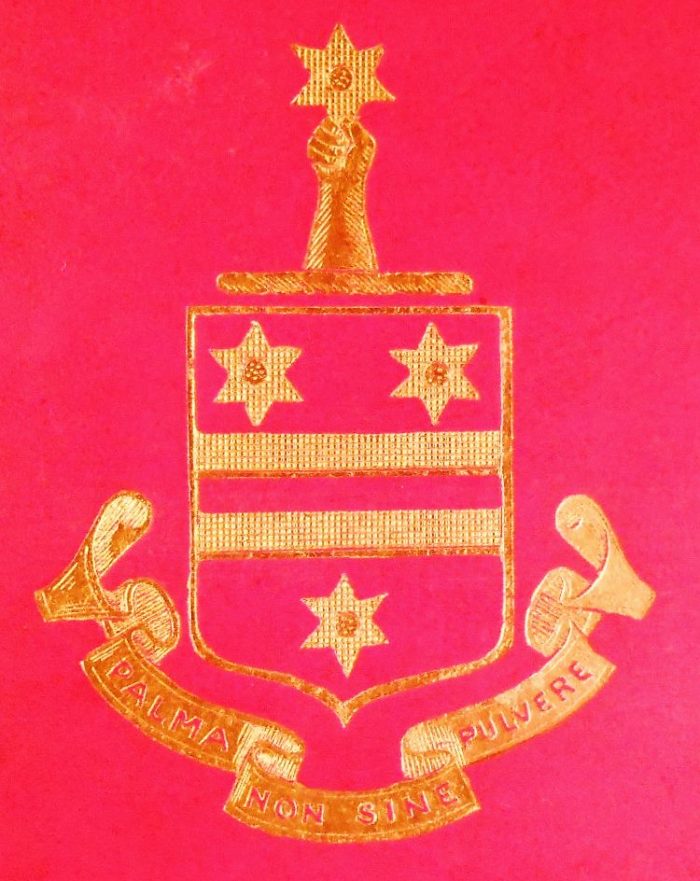[Sténographie]. Arthur George Doughty – Alfred Tennyson. The Idylls of the King, by Alfred, Lord Tennyson (Illustrated). In shorthand by Arthur G. Doughty. By kind permission of Messrs. MacMillan & Co. Montréal, Dominion illustrated Press, 1889. In-4°. 1 f. blanc, half title, title, [5] ff. (dédicace, préface, table du texte et de l’illustration, permission), 102 ff., 2 ff. white. Frontispice et 6 gravures hors-texte sous serpente. Plein box framboise de l’époque, back with 5 faux-nerfs orné de roulettes et filets dorés, pièces de titre en maroquin bleu et havane, armes dorées sur le plat supérieur, encadrement sur les plats d’un filet à froid et d’un double filet doré fleuronné en coins, large roulette dorée sur les chasses, gilt slices.
Rare copy, uniquement imprimé au recto, sur deux colonnes, dans un encadrement rouge de l’un des plus célèbres ouvrages de Tennyson paru en 1885, série de poèmes narratifs fondés entièrement sur le Roi Arthur et la Légende arthurienne et influencés, dans ses thèmes, par les premiers récits de Sir Thomas Malory sur ce roi légendaire. “Curieux volume imprimé à la Dominion illustrated Press, chaque page sur une vignette demi-ton. Les illustrations par H. Sandham. ” (P. Gagnon)
Henry Sandham (Montréal, 1842 – Londres, 1912) peintre de genre, portraitiste et illustrateur, fut membre fondateur de la Royal Canadian Academy of Arts. Les musées d’Ottawa et de Washington conservent certaines de ses œuvres. (Bénézit, IX, 273).
Exemplaire aux armes de sir Arthur George Doughty (Maidenhead, Angleterre, 1860 – Ottawa, 1936) avec sa devise « Palma non sine pulvere “. Le même exemplaire, mais relié en maroquin rose, également avec ses armes, se trouve aux Libraries of University of Toronto, section British Armorial Bindings, cote DOU011.
On sait peu de chose de Doughty avant sa nomination à la tête des Archives du Canada en 1904 qu’il dirigera remarquablement jusqu’en 1935. Immigré au Canada en 1886, il se lance en affaires et devient bientôt un membre actif des cercles littéraires de Montréal. Intéressé par la sténographie, Doughty avait déjà publié une version sténographique de In Memoriam de Tennyson, auteur qu’il vénérait au plus haut point ; il lui avait consacré plusieurs ouvrages et ses poèmes étaient très tennysoniens. Il transcrit The Idylls of the King du vivant du poète qui mourra 3 ans après, et tente sans succès d’en faire supporter la publication par le gouvernement canadien, arguant de l’intérêt pédagogique d’une telle réalisation, entièrement canadienne, la première de ce type dans le Dominion. Il était convaincu que l’apprentissage de la sténographie était indispensable au sein du système éducatif de son temps. Il semblerait cependant qu’il n’ait pas publié d’autres ouvrages sténographiques, et qu’il ait même, après sa nomination à la direction des archives du Dominion, occulté cet engouement qu’il considérait probablement quelque peu embarrassant.
Rare copy, printed only on the recto, on two columns, in a red frame. “Curious volume printed at the Dominion illustrated Press, each page on a half-tone vignette. Illustrations by H. Sandham.” (P. Gagnon).
Henry SANDHAM (Montreal, 1842 – London, 1912) was a genre painter, portraitist and illustrator, a founding member of the Royal Canadian Academy of Arts. The museums in Ottawa and Washington keep some of his works.
A copy of Sir Arthur George DOUGHTY (Maidenhead, England, 1860 – Ottawa, 1936) with his motto “Palma non sine pulvere”. The same copy, but bound in pink maroquin, also with its arms, can be found at the Libraries of University of Toronto, section British Armorial Bindings, rated DOU011.
Interested in shorthand, DOUGHTY had already published a shorthand version of In Memoriam by TENNYSON; he transcribed The Idylls of the King of the poet who died three years later, and tries unsuccessfully to have its publication supported by the Canadian government, arguing the pedagogical interest of such an achievement, entirely Canadian, the first of its kind in the Dominion. He was convinced that learning shorthand was essential for the educational system of his time. It would seem, however, that he had not published other shorthand works, and that he had even, after his appointment to the directorate of the Dominion archives, forget this infatuation which he probably considered somewhat embarrassing.
P. Gagnon, Essai de bibliographie canadienne, II, 678 ; Robert J. Hayward, Sir Arthur Doughty, Shorthand, and Alfred, Lord Tennyson, in Archivaria 21 (Winter 1985-86), pp. 103-110.
Léger ressaut de la gravure face au f. 51, rousseurs aux serpentes et aux gravures ; infime usure à la reliure. Très bel exemplaire.
Slight resurgence of the engraving in front of l. 51, few foxing on the engravings; slight wear to the binding. Very nice copy.
Sold
